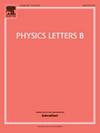从e+e−湮灭数据和对数色散关系得到介子横荷密度
IF 4.3
2区 物理与天体物理
Q1 ASTRONOMY & ASTROPHYSICS
引用次数: 0
摘要
从e+e−→π+π−独占湮灭数据的色散分析中提取了介子的横荷密度。用对数色散关系从湮灭截面的模量计算出类时介子形状因子的未知相位。该方法是模型无关的,并允许定量的不确定性估计。密度以低至b ~ 0.1 fm的精度获得;在较小的距离上,它在质量上取决于类时形状因子的假设高能行为。讨论了介子结构的意义和pQCD渐近性的相关性。本文章由计算机程序翻译,如有差异,请以英文原文为准。
Pion transverse charge density from e+e− annihilation data and logarithmic dispersion relations
The transverse charge density of the pion is extracted from a dispersive analysis of the exclusive annihilation data. A logarithmic dispersion relation is used to compute the unknown phase of the timelike pion form factor from the modulus obtained from the annihilation cross section. The method is model-independent and permits quantitative uncertainty estimates. The density is obtained with few-percent accuracy down to fm; at smaller distances it depends qualitatively on the assumed high-energy behavior of the timelike form factor. Implications for pion structure and the relevance of pQCD asymptotics are discussed.
求助全文
通过发布文献求助,成功后即可免费获取论文全文。
去求助
来源期刊

Physics Letters B
物理-物理:综合
CiteScore
9.10
自引率
6.80%
发文量
647
审稿时长
3 months
期刊介绍:
Physics Letters B ensures the rapid publication of important new results in particle physics, nuclear physics and cosmology. Specialized editors are responsible for contributions in experimental nuclear physics, theoretical nuclear physics, experimental high-energy physics, theoretical high-energy physics, and astrophysics.
 求助内容:
求助内容: 应助结果提醒方式:
应助结果提醒方式:


